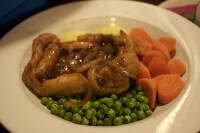
English food has gotten a bad rap for a long time. As Bill Buford once wondered, “How, for two centuries, has a country with so many resources—creams and butters and handmade cheeses, a practice of grass-feeding sheep and cattle, wild fish, abundant game—produced such a spectacularly loathsome fare? … The simple good ingredients were there: why weren’t people using them? Why did they seek out the substandard, the industrial, and the unhealthy: prawn cocktail crisps, say, or fish fingers with Birds Eye peas (a “traditional” Sunday supper), or a “spag bol,” that horrific canned imitation of a classic Bolognese pasta?”
The New Yorker writer and bestselling author went on,
The implicit complaint—that the English don’t care what they put in their mouths—was evident in how it got there: by scooping up most of what was on your plate and eating it in one bite. Using your knife, you crushed what you could onto the back of your fork, one item after the other, your starches (like that perennial favorite chips and mash), your green-gray veg, a modest protein, calculatedly overcooked, unless it was fish, in which case it was just outright obliterated, and then—bang!—into the mouth, fork upside down.
As England’s own Gordon Ramsay told Buford, “I really don’t know what English food is. Spotted dick? Toad-in-the-hole? Curry is the national dish, and people still fry Mars bars for dinner.”
And this is what Clarissa Dickson Wright has decided to take on: The idea that her country’s culinary offerings have always been bad. “English food in the 18th century was food to be proud of,” she recently wrote in the Washington Post, “so it is scarcely surprising that it should have been popular on both sides of the Atlantic. [Hannah] Glasse includes an astonishing array of dishes in her book: lots of meat and fish; plenty of sauces and soups; the first recorded curry dish in the English-speaking world (inspired by Britain’s trading presence in India); good substantial bread, fruit and rice puddings for which the English were famous, even among the French; and plenty of cakes and biscuits, cheesecakes, jellies and syllabubs.”
It was during the Victorian period that English food culture plunged into the Dark Ages. “This is the era when the strong, interesting flavors of earlier times gave way to blandness,” explains the former cohost of Two Fat Ladies.
Garlic fell out of fashion. The wonderful spices that had been a mainstay of English cooking since medieval times fell by the wayside. Instead, Victorian cooks, armed with their copy of “Mrs Beeton’s Book of Household Management,” came up with dreary dishes of brawn (head cheese) and mock turtle soup made with a calf’s head, ham and a pound of butter; vegetables were over-boiled and limp. All too often, when people think of “English cooking”—if they think of it at all—it’s the less-than-inspiring food of Victorian times that comes to mind, food that continued to be eaten in England until after World War II.
England’s current food culture is dramatically different. Wright’s essay in the Post is worth reading in its entirety. She is also working on a book, a history of English food, due out in October.
‘England’s own Gordon Ramsay’?
Lol. He’s Scottish. You can call him British but never, ever English.
RIPOFF!!!! there’s not one word about WHY the food changed, just that it happened sometime in the Victorian era.